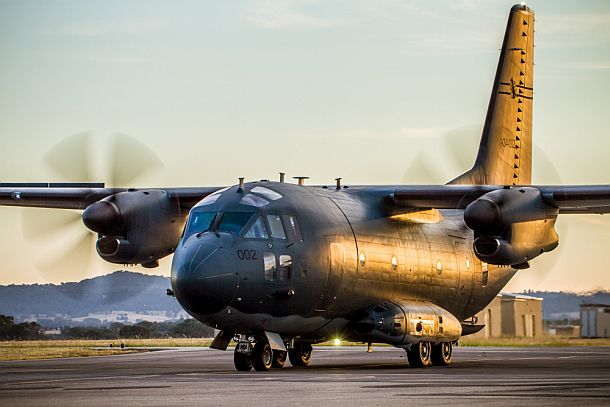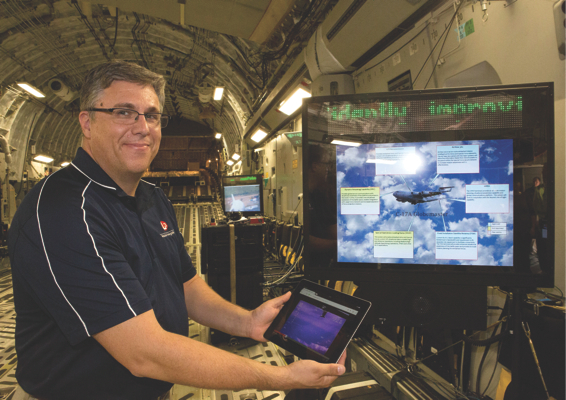The RAAF’s Air Mobility Group has enjoyed a busy 12 months, in which it has continued to enable and support operations in the Middle East, introduce new aircraft and roll-out an ongoing series of upgrades aimed at maximising existing capability.
Nigel Pittaway | Melbourne
In platform terms, this year the Australian Government announced the acquisition of two more Airbus KC-30A Multi-Role Tanker Transports, ordered – and received – two additional Boeing C-17A Globemaster heavy airlifters and released a Request For Proposal for replacement of the Special Purpose Aircraft (SPA) fleet, more widely known as the VIP fleet.
In addition, AMG took delivery of the first two Alenia Aermacchi C-27J Spartan battlefield airlifters at RAAF base Richmond and two others are already engaged in training Australian crews in the US.
Commander AMG Air Commodore Richard Lennon told ADM in December that the group initiated a program of adding new capabilities and strengthening existing capability under the overarching Air Force Plan Jericho more than a year ago.
“We are focussing on not only enhancing capability and making sure it is resilient and available, but also maximising the services and capabilities we offer the ADF, particularly in the amphibious context,” AIRCDRE Lennon said. “The add-ons we’re pursuing are the sorts of capabilities that help the user and provide a joint outcome for the ADF.”
AIRCDRE Lennon is pursuing two main themes for the immediate future. The first is innovation which, under Jericho, will ensure that fleet enhancements are consistent with the rest of Air Force and the wider ADF.
The second is a focus on teamwork, ensuring AMG is engaged with Air Force, CASG and industry, but also building trust and respect in the workplace. A recent example of the latter is the recent accreditation of AMG under the White Ribbon campaign to end violence against women.
“If you stand up against violence against women then you really are standing up for a lot of different issues we face in Air Force and the community faces in general,” AIRCDRE Lennon said. “It engenders respect, teamwork and goodwill throughout the organisation.”
MRTT
The KC-30A has continued to mature into a capable platform over the past year, with the boom system now operational and already cleared for use with other KC-30As and the RAAF’s Boeing E-7A Wedgetail, which has now undertaken operational air to air refuelling in the Middle East Area of Operations.
"The first two KC-30As are now undergoing modification at Amberley to fit the Large Aircraft Infra-Red Counter Measures (LAIRCM) defensive system."
In March 2015, following the successful boom remediation program, the KC-30A was removed from the Projects of Concern list and recent milestones include the successful conclusion of AAR trials with a US Air Force Lockheed Martin F-35A and initial trials with a USAF F-16C.
Operations in the MEAO over the last year have, in the words of AIRCDRE Lennon, now established it as the tanker of choice among RAAF and coalition partners.
“The crews are operating it in an innovative way. With the situational awareness the KC-30A offers the aircrew, they are able to see where their receivers are and actually move the tanker towards the fighters to reduce their transit time,” he said.
“Whilst they are refuelling they will take them where they need to go next, rather than maintaining a typical tanker racetrack pattern, so when they come off the tanker they’ve got a full load of gas, but less miles to the battle.”
The crews in the Middle East are also experimenting with the KC-30As Link 16 and SATCOM capabilities to provide additional flexibility.
“They’re looking at the way we deliver fuel on operations, things like moving around the airspace, so they are really exploring the capabilities of Link 16, SATCOM and other systems such as the radar, to maximise situational awareness and get the most flexibility out of the capability,” AIRCDRE Lennon continued.
The first two KC-30As are now undergoing modification at Amberley to fit the Large Aircraft Infra-Red Counter Measures (LAIRCM) defensive system and other capabilities such as an IP-based chat system are under consideration for the future.
In July 2015, the Government announced that two more aircraft will be acquired, taking the total to seven. These are ex-Qantas A330-200s, purchased to maintain as much airframe commonality as possible with the current fleet. Both aircraft are now in Spain awaiting conversion and are due to be delivered in 2018. See P46 for more.
Heavy airlift capability
Two additional C-17As were also purchased by the Government and arrived home at Amberley in July and November this year, bringing the total to eight – now double the number originally announced back in 2006.
“As soon as the decision on the additional (7th and 8th) aircraft was made, we began expanding our workforce so that we were ready to go, so that when the last aircraft arrived in November the workforce had already grown to a point where we could put it to work straight away,” AIRCDRE Lennon detailed.
“In fact they were put to work when they left America, when they arrived in Australia they already had 50 tonnes of cargo on board. It’s a great workhorse and they just integrated into the Australian fleet seamlessly.”
Recent capability enhancements to the fleet have included the integration of the AirView 360 integrated display system, which allows high definition video received via SATCOM to be displayed in the cargo compartment.
In November 2015, a trial WiFi capability was demonstrated in Canberra, which allows a Defence laptop or tablet to access information while in flight or on the ground in remote locations. See box for more detail on this program.
“We are now developing the AirView360 concept with our users on how best to put that to work and the next iteration is providing a WiFi solution to the aircraft,” AIRCDRE Lennon explained.
“It has lots of uses, for example in-flight planning for troops in transit to an operational area, or you could be travelling to a disaster site and need to access the latest weather or conditions on the ground, or an Aero Medical Evacuation team could be talking to specialists back on the ground about procedures or difficulties they may be having.
“We certainly won’t be using it as an In-Flight Entertainment system, because it’s expensive to use, in terms of bearer time on the satellite, but certainly there are plenty of operational scenarios where a wireless connection will come in handy.”
In November last year the RAAF C-17A operated its first ever Globemaster flight to Antarctica, when one aircraft delivered over 12 tonnes of cargo to Wilkins Airfield, adjacent to Casey Station. The flight was one of a series of trials in support of the Australian Antarctic Division.
“We’re looking to see how we can revolutionise logistics support for the Division and we’ve conducted three flights now which have been very successful,” AIRCDRE Lennon said. “I can tell you from first-hand experience that they are over the moon with the support and immediate response the C-17A can bring.”
Expanding Hercules capability
The growth of AMG’s large aircraft fleet (KC-30A & C-17A) has allowed the ubiquitous Lockheed Martin C-130J Hercules to focus more on combat airlift capabilities and these operations have been further enhanced by capability upgrades and a revamp of the training system.
In the last year the Hercules fleet has been fitted with SATCOM, Electronic Flight Bags have been added and a Dynamic Retasking Capability (DRC) is being installed in the first aircraft at the present time. A LAIRCM trial installation kit will be fitted to one aircraft in early 2016 and should be available for operations in contested areas by the middle of the year. Four aircraft will be modified in America and the balance of the work undertaken at Richmond.
The restructuring of the C-130 conversion course, including the concept of seat agility whereby either pilot can occupy either cockpit seat, has also enhanced operational flexibility and resulted in the graduation of co-pilots with a much wider skills base than in the past.
“We graduated a pilot’s conversion course in November and those crews can now do airdrop, at night, low-level, with night vision goggles, in the C-130 anywhere in the world,” AIRCDRE Lennon said. “That is something a graduate from the basic conversion course would not have been able to do two or three years ago.”
Enter the Spartan
The arrival of the first C-27J at Richmond at the end of June 2015, together with the delivery of a second aircraft, has allowed operational test and evaluation of AMG’s battlefield airlifter capability to begin. Air logistics support tasking and airdrop operations have already begun, with one of the main areas of focus now on maturing the supply line for the aircraft.

Air Force C-27J Spartan at RAAF Base Wagga. Credit: Defence
Overall program progress however has been slowed by a consolidation of Alenia’s facilities in Italy, which has delayed both aircraft and spare parts production and by the unfortunate US divesting of its Joint Cargo Aircraft.
This means that the fifth RAAF aircraft will not be delivered to Richmond until the end of 2016 and that some planned modifications will now be deferred.
“Instead of pursuing those modifications out of hand, we’re now talking with Alenia and other C-27J users about a sustainment program along the lines of the C-130 Joint User Group, where the main operators have sat down, compared ideas and pooled resources to make changes to the aircraft and we’re looking at doing exactly the same for the C-27J,” AIRCDRE Lennon detailed.Consolidating the King Air
With the introduction of the Spartan, the future of the Beechcraft King Air 350 fleet is currently under review and the fleet may be consolidated at RAAF East Sale in the 2018 timeframe. Two squadrons currently operate the aircraft; one based in Townsville for air logistics support and the other at East Sale, used to train Air Combat Officers for the ADF.
“We are looking at how we will roll those capabilities together in a consolidated squadron at East Sale, looking at how many aircraft we might have, modifying them or buying new aircraft,” AIRCDRE Lennon said.
“Essentially we can get better efficiencies out of combining the two fleets, but the Air Force is not pulling out of Townsville, we’re investing a lot in the base to support exercises and deployments and the King Air footprint there is relatively small.”
VIP fleet RFP
The Government released an RFP to industry in late 2015, seeking a managing contractor to manage the transition from the current BBJ and Challenger to new aircraft, to be acquired on a like for like basis.
“We are asking industry for more innovative ways of managing the SPA capability,” AIRCDRE Lennon said. “We are not dictating the numbers and types of aircraft, but we still need to get into all the small airstrips around Australia, we need to carry so many people between capital cities and we need to be able to fly overseas non-stop and facilitate the business of Government en-route.”
C-17As fitted for inflight tactical video link and wifiA suite of new capabilities on-board an Air Force C-17A Globemaster were showcased in Canberra in November last year including the provision of Wi-Fi internet access to portable Defence-issued electronic devices. The showcase is a part of Plan Jericho, Air Force’s plan to transform Air Force and the wider ADF into a fighting force that capitalises on the high technology systems that are being introduced over the next few years. This program for example took roughly 10 months from the good idea to delivery phase in 2015. |

Todd Stibor, from L3 Mission Integration, demonstrates the new wireless capability being brought to the C-17A Globemaster by wirelessly connecting up a Tablet. Credit: Defence
This article first appeared in the ADM February 2016 issue.




